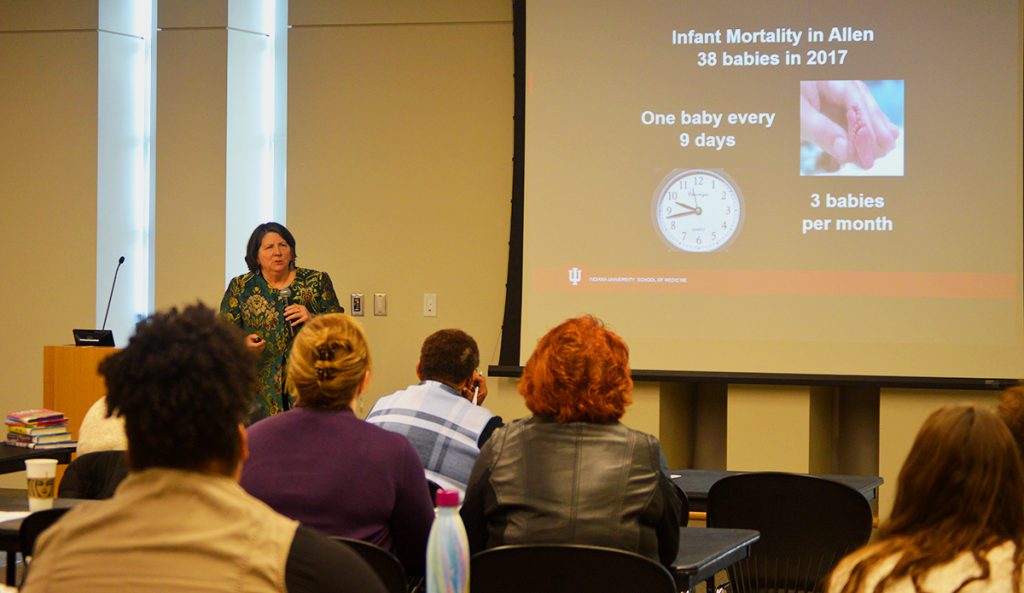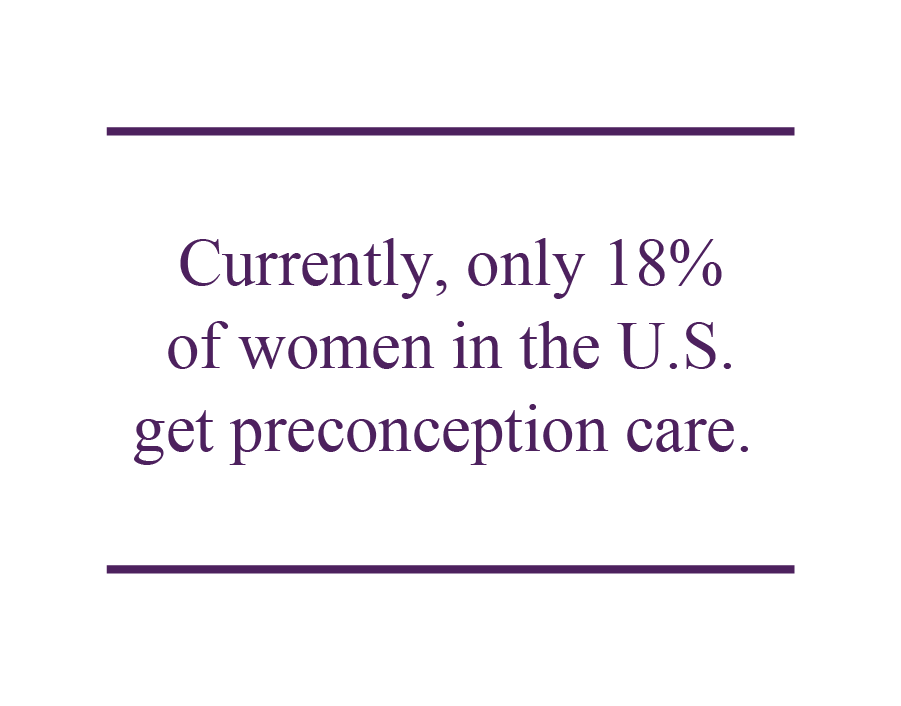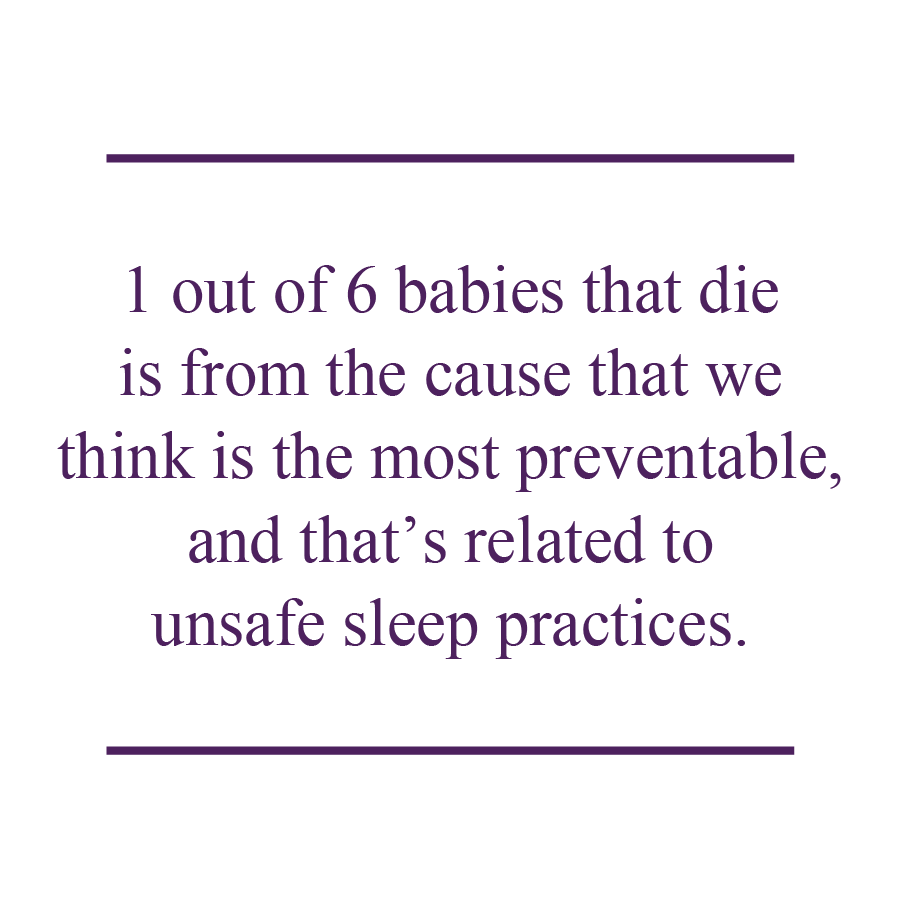Infant Mortality Crisis in Indiana

“By the time you wake up tomorrow morning, on average, another baby in Indiana has died.
In Allen County, 38 babies died in 2017, which is one baby every nine days, or three babies per month.”
Too many babies dying was the topic on February 20, when the St. Joe Foundation hosted its 20th Prenatal and Infant Care Network luncheon at the Allen County Public Library. Dr. Nancy Swigonski, MD, MPH, MBA, FAAP (I.U. School of Medicine) summarized the Infant Mortality crisis in Indiana, stating that in 2017, 602 babies died, or one baby every 16 hours, 1-2 per day. She complimented the data with several frameworks that successfully reduce infant mortality. Complementing this report, Erin Norton, RN, BSN, MBA (Parkview Health, Allen County Fetal Infant Mortality Review Committee) shared local findings and recommendations.
Dr. Swigonski explained, “If we want to attack Infant Mortality in our State, you need to be thinking about working in maternal health and infant health. By focusing on caring for women of childbearing years between pregnancies, recognizing that poor birth outcomes require interventions and risk reduction before pregnancy, especially in women with previous poor birth outcomes, we can move the needle,” said Dr. Swigonski. A promising new framework is the IMPLICIT (Interventions to Minimize Preterm & Low Birthweight Infants through Continuous Improvement Techniques) being developed by Dr. Emily Scott and the March of Dimes.

Currently, only 18% of women in the U.S. get preconception care. Pediatricians are now encouraged to screen Mothers for tobacco use, maternal depression, and other social determinants of health. “We need to support Moms after the baby is here.” Why? Because Maternal Mortality is on the rise in Indiana too. Approximately 700 women in the U.S. die due to pregnancy-related causes, 41 women are from Indiana. Women of color are 3 to 4 times as likely to die from childbirth complications than white women, and of these deaths, 60% are preventable according to data research.
Dr. Swigonski went on to say that, “1 out of 6 babies that die is from the cause that we think is the most preventable, and that’s related to unsafe sleep practices.” SUID (Sudden Unexpected Infant Death) rates are on the rise again in Indiana. She further stated that we need to focus on safe sleep environments and the ABC’s of safe sleep. Alone, on my Back, in my Crib. The key to education is not only working with the Mom, but with families, grandparents, and community relations. “Receiving verbal recommendations works much better than written recommendations. If you are handing out brochures, I would say you are wasting your time. You need to have those conversations and problem-solving discussions. How many people remember their favorite brochure from childhood?” commented Dr. Swigonski.
Fifty percent of what impacts our health can be attributed to Social and Economic Factors and Physical Environments. To address the high black infant mortality rate in Allen County and make lasting changes in health outcomes, Dr. Swigonski suggests a downstream approach to the problem. The first downstream event is to provide comprehensive clinical care. The midstream events address individual social needs (smoking, diet and nutrition, addiction), and the upstream events address community conditions and social determinants of health. (conditions in the environment in which people live, learn, work, play, worship, and age)
Dr. Swigonski concluded the discussion by reiterating that by using the models and frameworks presented and taking an upstream approach to address the conditions in our communities, we can move the needle and save our Moms and Babies.
For Allen County Moms and Babies, Erin Norton (Parkview Health) informed the participants about the FIMR (Fetal Infant Mortality Review) process, work, and recommendations. “The FIMR committee is a multidisciplinary team that gets together and reviews individual cases of when a baby dies in Allen County,” said Norton. They use data surrounding the death and maternal/family interviews that examine what “life was like” for the families during the pregnancy and through the first year of life. A Community Action Team (CAT) designs and implements interventions based on the FIMR report.
The first FIMR CAT recommendation is a Self-Care Toolkit. “What we found were that a lot of women who had experienced the death of a baby had some mental health concerns. It is really hard to get up and go to a doctor’s appointment when you are depressed,” stated Norton. Existing materials were not developed for mothers who had suffered a loss. The FIMR Mental Health Task Force team developed a self-care handout that is available in English and Spanish. All of the recommendations in the handout are no cost and easy to do for Moms. It opens the door to discussions on mental health and resources in the community.

The team also documented what they have discovered through the process. Most notable: not all deaths are preventable; those that were preventable had multiple risk factors present, the cases were complex, and there are many opportunities for improvement. So what can we change? We know that chronic maternal health issues contribute to poor outcomes. Preexisting conditions such as diabetes, hypertension, and depression contribute to poor pregnancy outcomes. Norton asked, “how can preconception health be improved? Is it smoking cessation, access to healthy foods, and primary care? Make sure you are talking to them about these issues, and remember women don’t have to be pregnant before you start these conversations.”
Norton also surmised that women are not taking Folic Acid and Prenatal Vitamins, nor are they accessing community resources such as the ones listed in the Prenatal Infant Care Resource Directory published by the St. Joe Foundation.
“One of the hardest things to hear is that women do not have social support in their lives,” said Norton. “We can do better.” Home visiting and the O.B. Navigator programs will assist in addressing this area. She also suggested better screenings for domestic abuse and mental health and identifying and addressing their social needs. “We can’t assume what is needed. We always need to ask”.
Other contributing factors or barriers to care identified in the FIMR cases include using Google for medical information, late or no prenatal care, no insurance or fear of paying, and unsafe sleep practices. Norton is very excited about having a consistent message and common safe sleep education in the community.
Norton encouraged thinking about something that one can do to make a change in our community and to contact her if they have an idea or suggestion for collaboration with the FIMR group. She closed by challenging the group, “What is the one thing you can do?”
Recent Stories
- Merry Christmas from the St. Joseph Community Health Foundation!
- St. Joe Foundation awards $2,652,998 to local agencies serving vulnerable individuals in Allen County, IN
- Prenatal & Infant Care Luncheon: a year of connection and learning
- Nourishing bodies and spirits: the impact of the Society of St. Vincent de Paul food and nutrition program
- Supporting sustainability in local food networks to improve access to nutritious food
